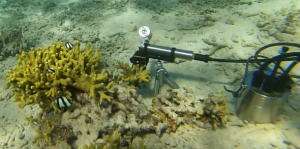Coral assessment using the Shutter Fluorometer
Aquation Shutter Fluorometers are particularly useful for measuring coral health.
As you can see in the images, the Shutter Fluorometer is positioned adjacent to, or over, a coral. Most of the time the Shutter is open, with the area of interest exposed to freely-flowing water and natural sunlight. When a measurement is due, the Shutter closes over the sample, excluding natural sunlight, and performs a saturating pulse measurement. Then, the Shutter can do two things. It can open again, and wait till the next measurement. This is useful for repeated yield measurements over the course of a day and in constructing diel yield curves. Or it can remain closed and the sample can be variously treated to actinic light (such as a rapid light curve), or left to dark acclimate for a predetermined interval, and then subjected to an Induction Curve. Another useful application is to subject the sample to an actinic light treatment (e.g. RLC), and then measure its recovery kinetics while the shutter remains closed.
Measurements of Fo’ are possible by closing the Shutter, taking a measurement and leaving the Shutter closed for 10 seconds with the Far Red Light on, followed by another saturating pulse measurement. Fo’ is used in a range of quenching calculations.
By programming the Submersible Datalogger, you can select the interval between measurements, and the type of actinic treatments to be applied.
These images demonstrate a single sensor Shutter Fluorometer taking in situ measurements of a coral in Fiji.

Shutter Fluorometer measuring photosynthesis of a coral. Note PAR sensor makes simultaneous light measurements, enabling calculation of Electron Transport rate (ETR) in situ.

Shutter Fluorometer and hard coral. Here the Shutter is open, allowing water and light to naturally influence the sample. The Submersible Datalogger is to the right of the coral in the image.




